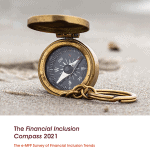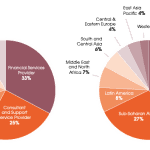Optimism, Confusion and Soul-Searching: The Financial Inclusion Compass 2019 Reveals a Sector at an Inflection Point
As a confusing and often frightening decade gives way to a new – hopefully more positive – one, it’s hard to avoid the sense that the world around us is getting ever more fiendishly complex. Increasingly, that complexity extends to the social impact sector: Just a look at NextBillion’s top 10 articles of 2019 is enough to make your head spin. From bullish forecasts on financial inclusion’s impact on the SDGs to alternative measurement frameworks that call these predictions into question, with similarly divergent takes on topics from behavioural economics to impact investing and off-grid energy, the sector has expanded beyond the grasp of any single generalist. It’s easy to feel hypnotized by the complexity of it all.
This feeling is no different when it comes to inclusive finance, a sector that expands in depth and breadth each year – from new products and players to increased expectations of rigor in determining impact. My colleagues at e-MFP and I spend a lot of time thinking about this bewildering landscape of trends in flux. In response, we saw the need for a broad survey of sector stakeholders – mixed-methodology in nature – that could somehow sift through the vast array of challenges, initiatives, experiments, risks, innovations and big ideas and distill a comprehensive look at the sector’s present and future. The first survey was published in late 2018 as the inaugural Financial Inclusion Compass 2018, and a year later, after soliciting feedback from various quarters, we did it all again. This latest Financial Inclusion Compass 2019 was launched at European Microfinance Week 2019 in November, at a workshop session with Renée Chau-Beroff from PAMIGA and Rupert Scofield from FINCA International.
Clarifying the Growing Complexity of Financial Inclusion
We like to think that the Compass fills a unique role in the financial inclusion sector. e-MFP is one of the few supra-sector organisations with members and friends working across so many sub-fields that their input can provide a genuine idea of what matters and what doesn’t, what’s going right, what isn’t, and what’s down the track. But with this diversity of viewpoints, the results are never going to be easy to make sense of. This recent Compass shows, certainly, the staggering complexity of the sector: It also demonstrates that its actors, in aggregate, are susceptible to information-overload – overwhelmed by the growing complexity of a sector that would be unrecognizable to many of their progenitors.
To help provide clarity, the report includes rankings of the trends it highlights, and it offers various quantitative takeaways. To take a few examples, the respondents to our survey of sector stakeholders (165 practitioners, funders, researchers, raters, regulators, analysts and others from over 40 countries) rated digital transformation of institutions, client protection and client-side technological innovation as the most important current trends. Looking five to 10 years ahead, respondents continue to be most bullish on agri-finance (as they were in the 2018 report), with climate change adaptation/mitigation and then SME finance rounding out the top three trends within the report’s New Areas of Focus Index.
While the quantitative results are interesting – and we do our best to be as accurate and rigorous as possible – this is still a survey, and self-selection bias can never be eliminated. But the real value of the Compass, we believe, is in the richness of the qualitative responses. Tens of thousands of words were submitted, in three languages, on the specific trends and areas of focus, the challenges and opportunities ahead, the opportunities for (and threats from) new entrants, and long-term forecasts for the health of the financial inclusion sector.
Key Themes from the Financial Inclusion Compass 2019
The themes that emerge from all these written responses don’t lend themselves to concise summary here. We hope you’ll take the time to read the Compass, with its spectrum of responses – ranging from the dogged optimists to the sky-is-falling “Chicken Littles” (and some just downright weird opinions in between) – and draw your own conclusions.
Despite the diversity of viewpoints about the trajectory of inclusive finance, one thing is clear: As we add layers of complexity to the sector, we tend to embark on a sort of “feedback loop” cycle of optimism, growth, groupthink, contrarianism, crisis, reflection and self-abnegation that obscures or confuses the underlying purpose of our work. Nevertheless, the 2019 Compass does reveal a sector at an inflection point of sorts. In aggregate, there is a now an enormous body of stakeholders with individual interests, passions and projects, but there’s also a collective (and growing?) soul-searching about what financial inclusion is actually for. This was evident not only in NextBillion’s top 10 articles of 2019, but also in CGAP’s equivalent list – which includes both Mayada El-Zoghbi’s excellent summary of the need for an updated theory of change to reflect how (and whether) the use of formal finance enhances poor customers’ well-being, and Matthew Soursourian’s fascinating tour of how financial health fits within the dizzying conceptual smorgasbord of access, uptake, usage, literacy, capability and inclusion.
These various articles on NextBillion, CGAP and the industry’s other key knowledge platforms (not to mention the academic work upon which they’re based) are important. They reveal a sector desperate to avoid the mistakes of the past – while determined to acquire a better understanding of what the inclusive finance movement is truly working toward.
But in spite of all the daunting complexity of this increasingly broad (and specialized) field, the value of the Compass, we hope, is in its paradoxical simplicity. At heart, it simply asks a whole lot of stakeholders their opinions on navigating an unclear future. By reflecting these viewpoints back, to be looked at again over time, we can see where we were right, where we were wrong, and where we may have lost our sense of direction along the way.
Sam Mendelson is Financial Inclusion Specialist at e-MFP, and the lead author of the Financial Inclusion Compass.
Photo courtesy of Enrico Strocchi.
- Categories
- Finance



